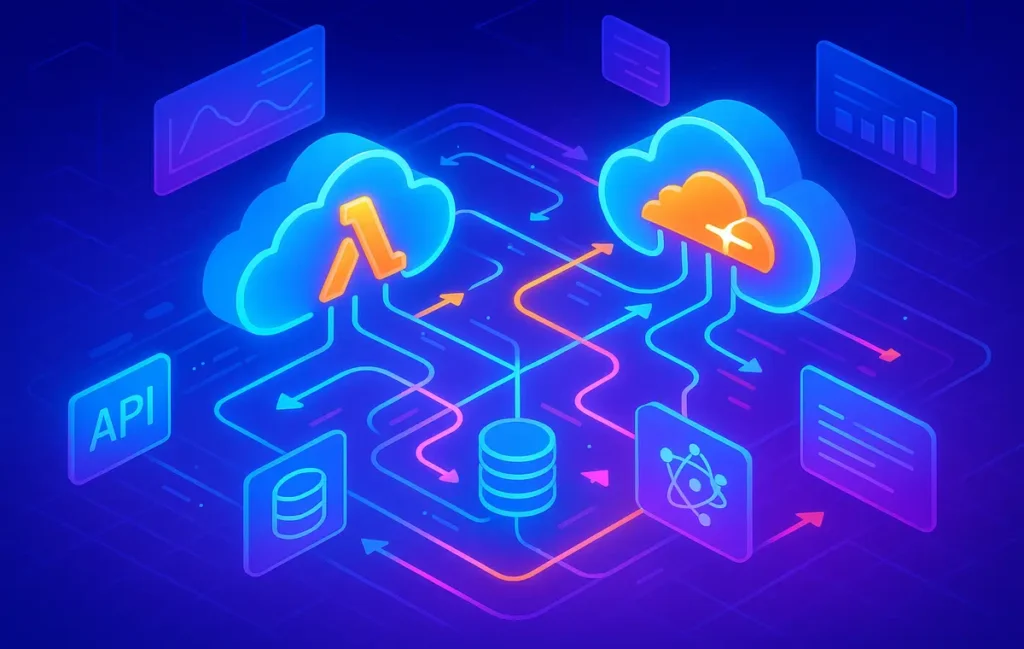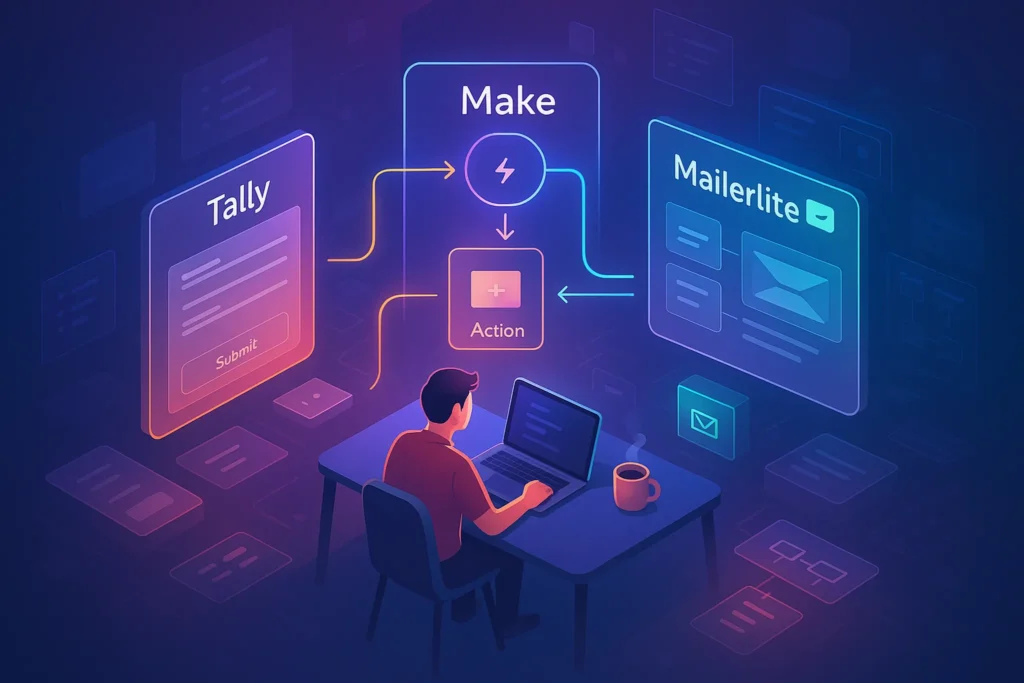🎯 Intro
Serverless automation has become one of the most disruptive trends in cloud computing. Imagine running code only when you need it—without renting or maintaining servers 24/7. No provisioning, no idle costs, just execution on demand. But the key question for creators, solopreneurs, and enterprises alike is this: can serverless truly replace traditional automation tools like Zapier or IFTTT, or is it a complementary layer?
In this NerdChips deep dive, we’ll unpack what serverless automation is, explore leading platforms like AWS Lambda and Cloudflare Workers, analyze real-world use cases, and highlight both the benefits and challenges. We’ll also connect serverless to no-code automation and show how the two worlds can converge.
💡 Nerd Tip: Don’t think of serverless as replacing automation tools. Think of it as adding superpowers to workflows that need more flexibility, speed, or raw processing power.
🔍 What is Serverless Automation?
Serverless automation is the practice of running functions in the cloud without provisioning or managing servers. Instead of spinning up a virtual machine or paying for infrastructure around the clock, you write small pieces of code—“functions”—that are triggered by events.
AWS Lambda popularized this model in 2014 by letting developers run event-driven functions, like processing an image upload the moment it hits Amazon S3. Since then, every major cloud provider has entered the race: Google Cloud Functions, Azure Functions, and more recently Cloudflare Workers, which run code at the network edge for ultra-low latency.
The difference between serverless and no-code tools like Zapier is that serverless is programmable. Zapier automates workflows with connectors between apps, while serverless lets you build any logic you can code. For example, Zapier may send a Slack alert when a form is submitted, but Lambda could also compress and archive the form’s file, enrich it with external APIs, and perform AI-driven analysis—all in milliseconds.
For beginners, serverless may sound complex. But in practice, it’s a pay-as-you-go system with clear triggers and actions, similar in spirit to Workflow Automation, only more flexible and infinitely scalable.
🛠️ Key Platforms in 2025
🚀 AWS Lambda
Still the leader in serverless computing, AWS Lambda is designed for event-driven workflows. It integrates seamlessly with other AWS services like S3, DynamoDB, and SNS. For businesses already in the Amazon ecosystem, Lambda is the obvious choice.
🌍 Cloudflare Workers
Unlike Lambda, Cloudflare Workers run at the edge—on Cloudflare’s global network. This means ultra-low latency, perfect for automations that need instant responses like authentication, caching, or personalization. For example, serving dynamic content in under 50ms to users worldwide.
☁️ Google Cloud Functions
GCP Functions excel when integrated into Google’s ecosystem. If your business relies heavily on Google Workspace, Firebase, or BigQuery, Cloud Functions become a natural fit.
🏢 Azure Functions
For enterprise-heavy organizations already embedded in Microsoft environments, Azure Functions provide native integration with Office 365, Teams, and Dynamics.
💡 Nerd Tip: Cloudflare Workers are unmatched for ultra-fast, lightweight functions. AWS Lambda is the go-to for heavier jobs with deep integration into cloud infrastructure.
⚡ Real-World Use Cases
Serverless automation isn’t just for developers—it’s already driving practical workflows across industries:
-
Data pipelines automation: Instead of managing ETL servers, serverless functions transform and route data on the fly.
-
Image and video processing: Lambda functions can resize, compress, or watermark media instantly when uploaded.
-
Real-time notifications: Workers can send alerts the moment an event is detected—faster than poll-based automation.
-
API orchestration for SaaS tools: Connect multiple APIs, enrich data, or run checks before sending to CRMs.
-
Lightweight ETL jobs: Replace expensive scheduled servers with functions triggered only when needed.
Creators are already mixing serverless with AI. For example, a function could call an AI model to summarize meeting notes or classify uploaded content before routing it. If you’ve explored Top Automation Workflows with HARPA AI, imagine plugging serverless into that stack for deeper customization.
💡 Nerd Tip: Test one use case first—like automating image compression. It proves the value without overwhelming you with complexity.
📈 Business ROI
The financial appeal of serverless is simple: you only pay for what you use. Traditional cloud servers charge even when idle. With Lambda or Workers, if your code doesn’t run, you don’t pay.
For SMBs and solopreneurs, this can mean massive savings. A marketing team running 5 million monthly function calls might pay less than $50 on AWS Lambda’s free and pay-per-execution tiers. Compare that with running a dedicated server at $100/month, regardless of usage.
Scalability is another ROI driver. You don’t have to plan for traffic spikes—serverless platforms scale automatically. A campaign going viral doesn’t mean downtime or surprise infrastructure crises.
Finally, removing infrastructure overhead frees developer time. Instead of managing servers, devs focus on writing logic. That translates into faster iteration cycles and lower long-term costs.
💡 Nerd Tip: Always factor in developer time saved. Serverless ROI isn’t just lower bills—it’s fewer hours wasted on infrastructure babysitting.
🚀 Implementation Guide
Transitioning into serverless automation doesn’t require a massive leap.
Start by choosing a platform based on your ecosystem. AWS Lambda if you’re on AWS, Cloudflare Workers if speed and global presence matter, GCP or Azure if you’re locked into those environments.
Begin with a “Hello World” function. Deploy it, test it, then connect it to a trigger: an S3 bucket, an HTTP request, or a cron job.
Add monitoring and logging early. Platforms like CloudWatch (AWS) or Workers KV (Cloudflare) make debugging easier. As you gain confidence, scale by chaining functions together or adding APIs.
For solopreneurs or remote teams already using no-code tools, serverless becomes a complement. For example, a Zapier workflow could call a Lambda function for heavy processing. This bridges the gap between Best Workflow Automation Tools for Solopreneurs & Remote Teams and custom code.
💡 Nerd Tip: Build small, reusable functions. Think “LEGO blocks” you can snap together, not giant monoliths that are hard to debug or scale.
⚠️ Challenges & Solutions
Serverless isn’t magic. It has challenges:
-
Cold starts: Functions not run recently may take a second or more to spin up. This matters for latency-sensitive apps. Solutions include provisioned concurrency or using Workers at the edge.
-
Vendor lock-in: Each provider has unique APIs. Switching from AWS to GCP isn’t trivial. Abstract your logic with middleware if you want flexibility.
-
Execution limits: Most providers cap runtime (e.g., 15 minutes on Lambda). Heavy tasks may need orchestration or container-based alternatives.
-
Skills gap: Serverless requires coding knowledge. Solopreneurs without dev skills may need to combine no-code with minimal-code serverless.
💡 Nerd Tip: Pair serverless with no-code automation. Let Zapier or n8n handle orchestration, and call serverless functions only when deeper logic or performance is required.
⚡ Run Your First Serverless Automation
Try AWS Lambda and Cloudflare Workers free tiers. Build small functions, connect triggers, and experience automation without servers or hassle.
📊 Serverless vs No-Code vs Traditional Automation
To really understand where serverless fits, it helps to compare it against no-code platforms and traditional server-based automation.
-
Traditional Automation: Think of cron jobs on a server or scripts running on a VM. These approaches give maximum control but require infrastructure management. Costs remain fixed, even when workloads are idle. Scaling means adding more servers or resources, often with delays and overhead.
-
No-Code Tools (like Zapier): Perfect for non-technical users. Easy to set up, strong ecosystem of integrations, but limited when workflows require heavy processing or deep customization. Costs rise as tasks grow, and flexibility is capped by connectors.
-
Serverless Automation: Combines flexibility and scalability. Functions execute on demand, with costs tied directly to usage. No infrastructure to manage, but you need coding skills. Unlike Zapier’s simplicity, serverless opens doors to advanced workflows like image analysis, ML inference, or complex API orchestration.
💡 Nerd Tip: If you’re a solopreneur, don’t view no-code vs serverless as either/or. Use both strategically—no-code for orchestration, serverless for specialized heavy lifting.
🔄 Hybrid Workflows: Best of Both Worlds
One of the most practical strategies in 2025 is blending no-code automation with serverless functions. Instead of replacing Zapier with Lambda, think about extending it. For instance, a marketing solopreneur can use Zapier to catch a new lead from a form, then trigger an AWS Lambda function that enriches the lead with third-party data, validates email deliverability, and pushes it back into the CRM.
This hybrid approach means you don’t need to code every workflow from scratch. Zapier handles the plumbing and easy integrations, while serverless takes on the “muscle work.” Tools like Top 10 Automation Tools for Marketers can orchestrate the high-level flow, but serverless ensures scalability when a step demands extra compute power.
💡 Nerd Tip: If a workflow step consistently feels slow or expensive in a no-code tool, ask yourself: “Could a serverless function handle this part better?”
⚡ Performance Benchmarks & Latency
Performance is where serverless shines—and sometimes stumbles.
Cold starts are the classic challenge. AWS Lambda functions that haven’t run recently can take 1–2 seconds to “wake up.” In contrast, Cloudflare Workers, which run at the edge, respond in under 200ms. For workflows requiring instant speed—like authenticating users or serving real-time content—Workers often outperform Lambda.
Benchmarks from real-world usage show Lambda excels for heavier workloads, like processing video files or running multi-second ETL jobs. Cloudflare Workers are best for lightweight logic executed at scale with minimal delay. Azure Functions and GCP Functions fall somewhere in between, depending on regional availability and ecosystem ties.
💡 Nerd Tip: Map your workflows by urgency. Use edge functions for low-latency needs (auth, personalization) and Lambda-style functions for bulk or heavy computation.
🧩 Case Study Snapshot: SaaS Startup Efficiency
Consider a SaaS startup offering analytics dashboards to SMB clients. Originally, they ran ETL pipelines on EC2 servers costing $2,500 monthly. The problem? Servers ran 24/7, even when workloads were low.
By migrating to AWS Lambda for ingestion and transformation, and Cloudflare Workers for real-time notifications, they cut infrastructure costs by 70%, dropping bills to under $800/month. Latency for customer alerts improved from ~3 seconds to under 300ms.
The real win was developer efficiency. Instead of patching and scaling servers, the team focused on improving analytics features. Time-to-market for new product features shrank by 30%. This case illustrates serverless ROI beyond dollars: it’s about agility.
💡 Nerd Tip: Calculate savings not only in infrastructure bills but also in developer hours freed up. Serverless gives back time you’d otherwise spend maintaining servers.
🔮 Future Outlook: Serverless + AI
Looking ahead, serverless automation is set to merge with AI-driven workflows. Already, functions can call AI APIs to summarize, classify, or generate data on the fly. But the future may look even more autonomous: serverless functions that self-trigger based on predictive signals rather than fixed events.
Imagine functions that spin up when an AI model forecasts traffic spikes, or automatically optimize routing when data anomalies are detected. This evolution could blur the line between traditional automation, no-code orchestration, and intelligent decision-making.
At NerdChips, we see serverless becoming not just a tool for execution, but an AI-aware automation layer. Instead of waiting for instructions, tomorrow’s functions may act more like micro-agents—self-learning, context-aware, and dynamically scaling.
💡 Nerd Tip: Start experimenting with serverless + AI today. Even a simple Lambda function calling an AI API can spark ideas for the workflows of tomorrow.
📬 Want More Smart Automation Insights?
Subscribe for weekly strategies on serverless, no-code automation, and AI workflows—straight from NerdChips to your inbox.
🔐 100% privacy. Only high-value automation insights, no noise.
🧠 Nerd Verdict
Serverless automation isn’t just hype—it’s a real evolution in how we run code. It slashes costs, scales instantly, and opens the door to creative workflows impossible in traditional setups. For development teams, it belongs in the core stack. For solopreneurs and creators, it acts as a complement to no-code platforms: when Zapier can’t handle the logic, serverless fills the gap.
At NerdChips, our take is clear: serverless automation is the next layer of workflow innovation. The brands, startups, and creators who experiment with it today will be the ones ahead tomorrow.
❓ FAQ: Nerds Ask, We Answer
💬 Would You Bite?
Would you try building your first serverless function to see how it transforms your workflow—or stick with traditional automation tools for now?
Crafted by NerdChips for builders, solopreneurs, and teams embracing the next era of automation.



